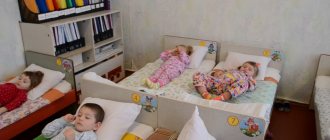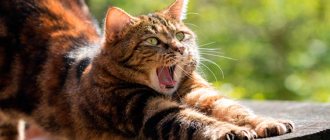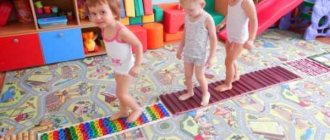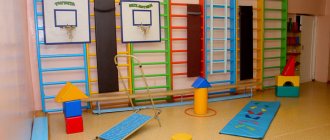Gymnastics after sleep in the senior group
Short-term gymnastics after a nap helps educators maintain a healthy mind in a healthy body and invigorate the child. She carefully and smoothly helps children wake up, fill themselves with strength and vigor.
Invigorating gymnastics after sleep
What is it and what is it for?
Gymnastics after sleep in the older group is a set of exercises that helps children gradually move from a state of rest to wakefulness. On average, older preschoolers are given an average of 5 to 8 minutes to do exercises after waking up.
Gymnastics is necessary for the following:
- effective awakening;
- improving mood and emotional state;
- health promotion;
- prevention of colds;
- increasing muscle tone;
- preventing the development of disorders in the musculoskeletal system, scoliosis and flat feet;
- formation of healthy lifestyle habits.
Important! The teacher must closely monitor the performance of the exercises and explain to the students that they must be performed smoothly, without sudden movements. Otherwise, muscle strain and dizziness may occur.
The main purpose of exercises after a nap is to prevent irritability in preschoolers (if they still want to sleep), anxiety and the formation of a favorable emotional background in the group, as well as to improve and develop coordination of movements in children.
In order to achieve the desired results from a set of exercises, it is very important to carry them out correctly. It is recommended to draw up lesson notes taking into account those that preceded them. Immediately after waking up, the teacher should set the students up to do the exercises. When performing them, the room temperature should be maintained at 16 to 18 degrees. If some students wake up earlier than others, it is recommended to come up with additional activities for them that they can do. Children are not recommended to go barefoot during ARVI outbreaks.
Organization of awakening in the second junior group
Charging should be planned in advance. If a role-playing game was held in the first half of the day, then thematic awakening gymnastics would be an excellent continuation.
The complex must contain:
- Exercises in bed;
- Vigorous activity (jumping, walking, squats, running);
- Hardening (walking on objects that feel different to the touch (stones, sand), wiping with a cool towel).
Rules for performing game gymnastics
Some rules of gymnastics after a nap:
- The room temperature should not be lower than 16 and higher than 25 degrees.
- To perform the awakening charge, you do not need special clothes or shoes; shorts and a T-shirt are enough.
- Children should not be required to perform assigned exercises. And those who wake up early should be taught self-massage with special balls.
- By time: exercises in bed - no more than 2 minutes, active load - 3 minutes, hardening - 3 minutes.
Gymnastics in the junior group of preschool educational institutions
Methodology for conducting invigorating gymnastics in preschool educational institutions
In order for gymnastics after sleep in the older group to bring the expected results, it must combine several types of exercises. It is not recommended to include strength or endurance exercises in your post-sleep activities. The adequacy of the chosen load can be assessed by the children’s well-being after performing the exercises. If exercises invigorate, make children energetic and cheerful, then the load is optimally chosen.
Note! In the senior group of kindergarten, pupils can repeat previously learned exercises without a teacher, since at this age children have a very developed memory.
Methodology for conducting invigorating gymnastics in preschool educational institutions
Making a time plan
To maintain children's interest and emotional state, it is recommended to adhere to a time plan that regulates the implementation of each block.
After waking up, exercises are carried out in bed for 1.5-2.5 minutes. Then a transition is made to the active block, which involves performing gymnastics near the cribs. Its duration should vary from 2 to 3 minutes. After this, breathing exercises are performed for several minutes. The complex is completed by walking for one minute on massage mats.
Exercises for correct posture in preschool children
Summary of awakening gymnastics in the senior group
When compiling notes, many teachers in the middle group of kindergarten prefer to use the book “Physical Culture of Penzulaev 4-5.” It describes in detail all the exercises that help preschoolers develop physically correctly, be cheerful and vigorous.
Note! When compiling notes, it is important to understand that the main goal of the classes is to form the habit of a healthy lifestyle and independent exercise at home.
Exercise after sleep
Charging analysis
To get a general impression of the effectiveness of children's gymnastics after wake-up in the older group, it is necessary to regularly conduct analysis. The development of the analysis scheme is carried out by the methodological team of the kindergarten. Monitoring is carried out every month and determines how effectively certain techniques are used.
When conducting an analysis, an analytical report must be written, which indicates the name of the preschool educational institution, the name of the teacher, the age of the students and their number, and necessarily the date of the gymnastics. After this, the results of the activity are directly entered into.
On the topic: methodological developments, presentations and notes
When selecting sets of exercises for a gymnast after sleep, I was faced with the fact that from the variety that I found in books and the Internet, not all of them were to my liking or really suitable.
Invigorating gymnastics “Dreams fly out the window” for the preparatory group.
After sleep, the child’s body requires a gradual “awakening” and preparation for active activity. Therefore, after the children get up, it is advisable to carry out a set of physical exercises, which will help.
Source
Complexes of health-improving gymnastics after sleep for children 5-6 years old
Health-improving gymnastics in the senior group has acquired particular relevance in recent years. This is explained primarily by the fact that the health of preschool children has steadily deteriorated. The set of exercises after sleep should include only gentle exercises and hardening elements.
Note! It should be performed only by those children who have no contraindications or restrictions to their implementation.
Gymnastics in bed
Before starting charging, the teacher must carefully prepare the room. He should open the curtains, open the window, especially in summer, spring and autumn, and play a quiet melody. For older children, the following exercises in bed are recommended:
- Stretching - children lie on their backs and lower their arms along the body. Then, one by one, they raise their arms up and stretch.
- Self-massage of the head - the teacher asks the children to sit on the bed and imitate washing their hair.
- We rest - the pupils lie on their stomachs with support on their elbows. The chin is supported by the palms. The teacher asks the children to alternately bend and straighten their knees.
Note! Exercises in bed help to gradually restore muscle tone after sleep and prepare them for active action.
Gymnastics in bed
Prevention of flat feet
Special attention is paid to the prevention of flat feet in preschool institutions, since this disease has become very common among children. Children's age is more favorable for correcting the feet. After sleep, orthopedic massage mats are used in kindergartens for prevention purposes. Children walk on them barefoot immediately after their nap.
Prevention of postural disorders
Children should develop correct posture from an early age, so it is very important that children in preschool institutions perform special exercises aimed at preventing scoliosis. The main measures that will help prevent postural disorders are considered to be a set of exercises aimed at improving it.
Methods of physical education
Note! Preschool children are recommended to perform special exercises while standing near a vertical plane. Therefore, many educators prefer to do exercises with children after sleep near their cribs.
Breathing and sound gymnastics
A set of special exercises that are aimed at improving health and developing the child’s ability to relax is classified as breathing and sound gymnastics. The main goal of the teacher when performing such exercises is the desire to teach each child to breathe deeply and correctly, to be able to coordinate their own movements, to develop the speech apparatus and to cheer up after a nap.
Among other things, elementary exercises help to form the sound culture of speech and correct sound pronunciation disorders in childhood. The following exercises are considered the most common and effective:
- "Watch."
- "Cockerel."
- "Pump".
- "Semaphore".
- "Merry little engine."
Note! If a child has no speech problems at all, there is no point in giving up sound-breathing exercises in kindergarten, since the exercises will never hurt.
Breathing exercises
Types of awakening gymnastics
Different types of gymnastics are designed to solve specific problems. That's why wake-up exercises are so often planned weeks in advance. For example, in the first complex, children warm up exclusively in their beds. The second complex includes active types of exercises, such as jumping and squats.
Types of awakening gymnastics:
- Breathing exercises;
- Musical and rhythmic classes;
- Corrective exercises and complexes (preventing flat feet (walking on mats with different surfaces) or diseases (hardening));
- Exercises with equipment (hoops, balls, etc.);
- Role-playing games;
- Warm up in bed.
In summer, it is recommended to do gymnastics outside in sneakers or Czech shoes. A light warm-up in this case includes running, jumping, squats, walking on massage surfaces and hardening.
Additional Information! All the necessary exercises can be taken from the book by L. I. Penzulaeva “Physical training (for children 3-4 years old).”
Educational games and activities for children 3 years old
Varieties of awakening gymnastics
Card index of awakening gymnastics according to the Federal State Educational Standard
Gymnastics after sleep (junior group 2), card index according to the Federal State Educational Standard:
| Name of exercises | Description |
| "Stretch" | Lying down, while inhaling, stretch your arms up and your legs forward with all your might. |
| "Komarik" | Starting position: on your back, clap your straight arms in front of you, “catching” a mosquito. |
| "Balls" | Jumping near the bed. |
| "Big small" | Starting position: standing. To the word “big” (count “one”), the child straightens up to his full height, to “small” (count “two”) - he crouches and shrinks into a ball. |
| "Kolobok" | Lying on the bed, turn your torso left and right. |
| "Cat - Dog" | Starting position - on all fours. For the word “cat”, arch your back. When pronouncing “doggy”, bend over (you can wag your “tail” - legs crossed behind you). |
| "Bike" | Performed mainly in the summer. Lying on their backs, kids pretend to ride a bicycle with their feet. |
| "Monkeys" | Starting position - on your back, arms bent at the elbows and pressed to the chest. Alternately straighten one hand and then the other, “plucking” bananas from an imaginary tree. |
| "Let's sunbathe on the beach" | Lying on your back, bend your legs alternately towards your chest. |
Exercises in bed and music-rhythm block
The most common combination in awakening gymnastics is poetry, music and the exercises themselves.
Musical-rhythmic block of awakening gymnastics
Here is one of the complexes that can be carried out without lifting the baby from the bed:
- “Stretch” (stretch for 5-10 seconds);
- “Komarik” (clap 5-10 times);
- “Bicycle” (performs for 10-15 seconds);
- “Musicians” (performed to the rhyme):
Methods for diagnosing and developing memory in preschool children
“We played the harmonica and clapped our hands (the kids clap several times);
Legs - top! top! (stomp on the bed);
Hands - clap! clap! (clap in front of themselves);
And we lower our palms (relax, stretch our arms along the body).
Let's rest."




